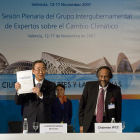By: Chandrika Nath
Send to a friend
The details you provide on this page will not be used to send unsolicited email, and will not be sold to a 3rd party. See privacy policy.
Uncertainty is part of science but it's no excuse for indecision. Chandrika Nath shows how to communicate uncertainty to policymakers.
As a scientist, you know uncertainty is intrinsic to science. Not all questions can be answered with 100 per cent certainty and even widely accepted theories can be challenged by new evidence.
But non-scientists — and that includes most policymakers — are less aware of this. Rather, policymakers look to scientists for definitive answers that help them make decisions.
So how can you give policymakers the information they need while also communicating science's inherent uncertainty?
Sources of uncertainty
Natural systems are inherently variable. Whether in climate systems or human reactions to new medicines, variability can make predictions uncertain.
Measuring things also comes with uncertainty. No measurement is 100 per cent accurate — the instruments we use, the people measuring, and many other factors, all introduce inaccuracies, and hence uncertainty.
Related to this is statistical error (and experimental design). For example, uncertainty in clinical trials is linked to the size of the trial. The fewer the people involved, the lower a study's statistical power to give a reliable result.
Crucially, uncertainty also comes from incomplete knowledge — particularly in complex systems. For example, there is much we don't know about clouds. Since they are important in determining how much solar energy reaches the Earth's surface, our incomplete knowledge introduces uncertainty into climate change predictions.

Uncertainty can arise when dealing with complex systems such as clouds
Flickr/CIFOR
Some uncertainties can be reduced by collecting more or better data. But uncertainties in complex natural systems, like the Earth's weather, mean no practical amount of research will give certainty. We will never know exactly what the weather will be in three weeks time.
Uncertainty generates indecision
Uncertainty drives science forwards, and keeps scientists looking for answers. The 20th century physicist Richard Feynman once said "it's much more interesting to live not knowing, than to have answers which might be wrong".
But for policymakers, uncertainty is problematic, particularly around controversial choices on the environment or public health. Policymakers like to have definite answers — an impossibility in science.
So while uncertainty leads scientists to action, it can lead policymakers to indecision. They often delay action in the hope of eliminating uncertainty. And sometimes policymakers use uncertainty as an excuse not to make unpopular or costly decisions.
Perhaps the most important thing to communicate to policymakers is that uncertainty does not equate to flawed science. For example, the vast majority of scientists are certain that climate change is happening, even if they remain uncertain about the exact outcomes.
A simpler way of putting this may be: "We don't know everything, but do we know enough to act?"
How certain is certain enough?
The 'enough' is the crux of the matter, and being able to communicate the level of uncertainty in information you present to policymakers is crucial. Make uncertainty understandable. That is much more useful than a simple "We don't know".
Sometimes we have a reasonably clear idea of what might happen if a decision is taken, and how likely that outcome is. In these situations use probability statements that back up your conclusions.
Present the most likely and a few other outcomes. For example, say that, from available data, there is an X per cent chance that outcome 'A' will occur in the next 100 years and an X per cent chance that outcome 'B' will occur.
The Intergovernmental Panel on Climate Change (IPCC) has developed a 'likelihood scale' that can help link probabilities to everyday language. When they say it is "extremely likely that humans have exerted a substantial warming influence on climate" they specify that they mean there is a "more than 95 per cent probability" of that being the case.
However, there is evidence that even if people know about the likelihood scale, each person still interprets qualitative phrases in their own way. So give the actual percentages too.

IPCC reports use a likelihood scale to describe probabilities
Flickr/United Nations Photo
Explain, as simply as possible, where the main uncertainties arise in the evidence you are laying out. What are the limitations in any model you have used? Are you relying on only a small number of studies? Could more research reduce some of the uncertainties? Be transparent about the assumptions that have been made in each case, and about the quality of the evidence.
It may help decision-making if you present a range of outcomes that also take into account different actions. For example, climate change scientists present the possible outcomes of severely cutting greenhouse gases, cutting them a little and not cutting them at all.
Not all uncertainty is quantifiable, particularly when we are making predictions about the future, which depend on many unknown factors. But such uncertainty should still be acknowledged and factored into plans.
Officials making plans for future pandemics may wish to prepare for the scenario scientists are most certain about — that there will be a pandemic virus in the foreseeable future — while still taking into account that the particular virus involved cannot be accurately predicted. For example, the swine flu pandemic showed that emergency plans should not be based only on knowledge of avian flu.
Outside influences
Science is only one of many factors that policymakers consider when making decisions — for example they also weigh up the cost of action, and how the public will respond.
As early as the 1970s, scientists were concerned about the consequences of human-caused global warming. But the first international agreement to combat it did not come into force until 1997. The political decision was delayed in part because of scientific uncertainty.
Decisions will also vary between people and places, and policymakers faced with similar levels of uncertainty can make widely different decisions. For example, there are uncertainties surrounding the safety of GM crops for human health and the environment, and the European Union has approved only a handful of GM crops, in part due to member states differing positions on the safety of GM technology.
But in other cases policymakers have used a different approach. Even though uncertainties remain over its long-term impact, GM cotton accounts for 40 per cent of all cultivated cotton worldwide.

GM cotton is grown worldwide despite uncertainties over long-term impact
Flickr/cliff1066™
Clear on uncertainties
Scientists have little control over how policymakers use their findings but they must still communicate clearly and openly about any uncertainty in the information they present. Doing so helps to ensure that uncertainties are not underplayed, overplayed, or ignored for political gain.
It is important to be honest and transparent about where your evidence comes from. However passionately you feel about an issue, do not focus on only the extreme scenarios. Try to convey the range of possible outcomes.
Be as neutral and objective as possible and let the facts speak for themselves. Don't paint either a 'doom and gloom' picture or an overly positive picture if the data don't back it up.
Don't focus too much on what you don't know at the expense of what you do know — find a meaningful balance between the two.
Be careful not to make your statements too vague in the process of translating scientific information into language that policymakers will understand. Avoid using phrases "a substantial increase" or "a small reduction" without quantifying them. How substantial? How small?
Yet there can be room for subjectivity, provided that it is rooted in experience. Sometimes, if uncertainty can't be reliably quantified, you can synthesise the subjective opinions of a group of experts. This is known as 'expert elicitation'. It is often used when making predictions related to climate change.
We don't yet understand what the temperature threshold is for reaching a 'tipping point' in the Earth's climate. So one way of shedding light on this is to ask experts what they think the threshold is, based on their familiarity with existing data. But when you tell policymakers about uncertainties you should state whether they are based on opinion or on objective science.
Getting your message across
Making sure that you communicate uncertainty in all your contact with policymakers should mean that, over time, they become more familiar with the concept, and more confident about making decisions despite uncertainty. See SciDev.Net's guide to briefing policymakers for more general tips on briefing policymakers.
So when formulating messages for policymakers, make sure you always include something about the unknowns, however tempting it is to omit them for potentially more interesting messages.
And try to share what you have learned about communicating uncertainty with colleagues so other scientists don't 'reinvent the wheel'. Consider giving a group talk in your department or producing some written guidance. Offer yourself as a mentor to colleagues looking to do the same thing. Finally, keep looking out for opportunities to give another briefing. After all, practice makes perfect.
Chandrika Nath is a scientific adviser at the Parliamentary Office of Science and Technology in the UK, where she also runs a project to help African parliaments find ways of providing their politicians with reliable scientific information.

